Choosing the right prosthetic foot is one of the most important steps in your mobility journey. Whether you are a below-knee (transtibial) or above-knee (transfemoral) amputee, the type of foot you use can affect how you walk, how much energy you use, and how comfortable you feel throughout the day. The right foot helps you move naturally, stay active, and feel more balanced and in control of every step.
At Robobionics, we work closely with amputees across India to find prosthetic feet that fit their lifestyle, activity level, and personal goals. Over the years, we’ve seen how the right match can change lives—making walking easier, reducing pain, and giving people the freedom to return to work, family, and their favorite daily routines. In this article, we’ll explore the best prosthetic foot options available in 2024 and explain how to choose one that supports your mobility, strength, and independence.
Understanding What a Prosthetic Foot Does
Before we look at the types of feet, it’s important to understand the role a prosthetic foot plays in your movement. Many people assume it just replaces the missing part of the leg. But it does much more than that—it helps you stand, balance, walk, and move with less strain on the rest of your body.
How the Foot Supports Movement
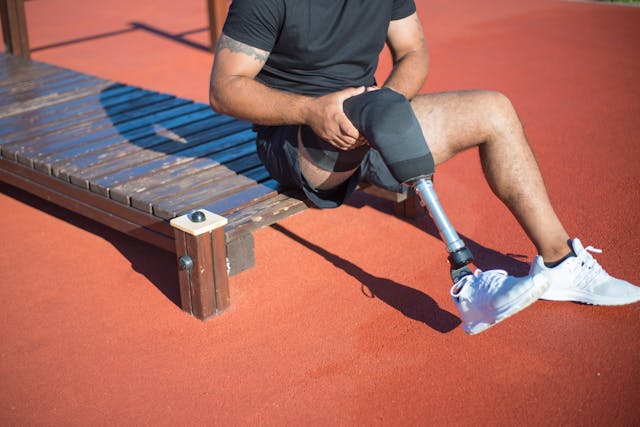
Every time you walk, your foot touches the ground and sends signals to the rest of your body. It tells your muscles how to adjust, helps keep your body balanced, and supports the shift of weight from one step to the next. A prosthetic foot must take on this job—absorbing impact, rolling forward smoothly, and pushing you ahead with each step.
If the foot doesn’t move correctly, the rest of the body has to work harder. This can lead to back pain, joint fatigue, or poor posture. That’s why it’s so important to choose a foot that not only fits well but also works well with the rest of your prosthetic system—especially if you’re using a prosthetic knee too.
Robobionics helps you test different foot types during your demo and trial period so you can feel how each one affects your movement. It’s not about picking the most advanced option—it’s about choosing the one that feels the most natural for your daily life.
Why Below-Knee and Above-Knee Needs Are Different
If you have a below-knee amputation, your natural knee still helps guide your steps. This gives you more control and allows for simpler foot designs that focus on energy return and ground contact. You don’t need the foot to help with knee motion—your body does that part already.
Above-knee users, on the other hand, rely on both a prosthetic foot and a prosthetic knee. These two components must work together smoothly to support standing, sitting, climbing stairs, or walking on uneven ground. The foot must provide extra support and be more responsive to changes in balance or movement.
That’s why the best foot for a transtibial user may not be the right one for a transfemoral user. At Robobionics, we carefully study how the entire prosthetic system works together before suggesting a specific type of foot.
Comfort and Energy Use Matter Most
No matter your amputation level, the main goal is the same: to walk comfortably and use as little extra energy as possible. A well-designed prosthetic foot reduces the stress on your hips, back, and sound leg. It makes every step smoother and helps you stay active for longer without feeling tired or sore.
Comfort is not just about soft padding. It’s about how the foot responds to movement—how it feels when you’re standing still, walking fast, or going up a slope. A responsive foot supports your body weight evenly and helps you move with confidence.
At Robobionics, we consider all these factors before recommending the right foot for you. We believe the best technology is the one that makes your day easier—not more complicated.
Solid Ankle Cushioned Heel (SACH) Foot
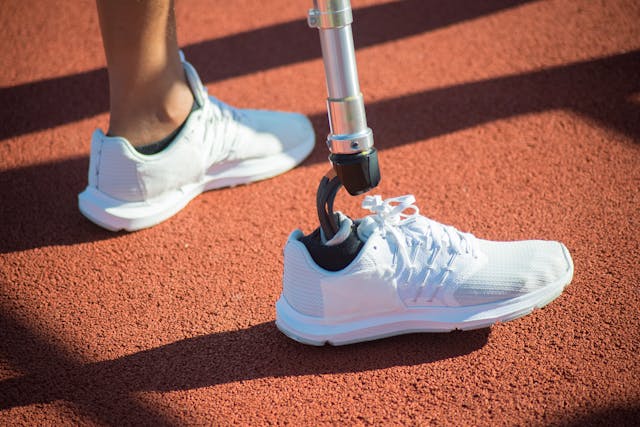
One of the most basic but still widely used prosthetic feet is the SACH foot. It has no moving parts and uses a cushioned heel to absorb shock. While it’s not high-tech, it remains a reliable option for many users—especially those with lower activity levels or those who are new to using a prosthesis.
How the SACH Foot Works
The SACH foot has a solid internal structure and a soft outer layer that compresses slightly when the heel touches the ground. This creates a smooth feeling during the first part of the step. The front part of the foot is stiff, so it helps push the body forward during walking.
Because it doesn’t bend at the ankle, it limits side-to-side motion, which gives more stability during standing. This is helpful for users who are just learning to walk again or who prefer a simple, low-maintenance option.
At Robobionics, we sometimes recommend SACH feet for older users, new amputees, or those who prefer a foot that doesn’t require fine control or regular adjustments.
Best Fit for Below-Knee Users
For transtibial amputees, the SACH foot can offer a steady walking pattern when paired with a well-aligned socket. Since the user already has a functioning knee, they can rely on their own leg to adjust their steps, while the SACH foot provides a firm base.
This foot is especially useful for walking indoors, on flat surfaces, or for short distances. It is not ideal for active users who need quick turns or who walk on uneven ground, but it works well for basic daily use.
Robobionics custom fits each SACH foot to the correct height and alignment, making sure users feel secure and comfortable during movement.
Limited Use for Above-Knee Amputees
For transfemoral users, the SACH foot is not often recommended because it lacks the flexibility and response needed to support the prosthetic knee. Without proper ankle movement, the foot can make walking feel stiff or unnatural when paired with an artificial knee.
Some low-activity transfemoral users may still use a SACH foot for short indoor walking, but most benefit from a foot with more motion and adaptability.
At Robobionics, we usually recommend more dynamic feet for above-knee users so the entire prosthetic system can work together more smoothly.
Single-Axis and Multi-Axis Feet
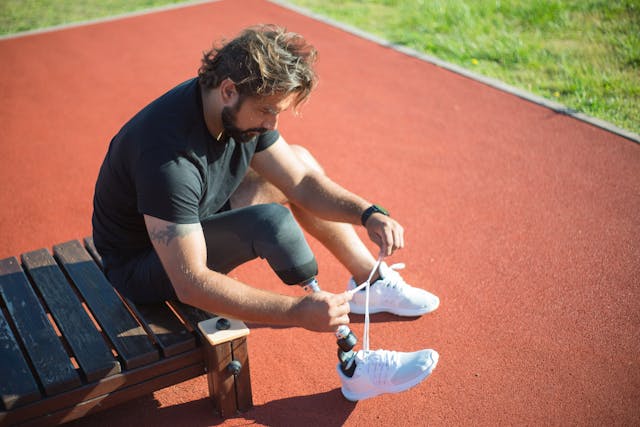
As prosthetic technology improved, feet with more movement were introduced. Single-axis and multi-axis feet allow the ankle to bend slightly, helping users walk more naturally on different surfaces.
How These Feet Improve Motion
A single-axis foot allows up-and-down motion at the ankle. This means the toe lifts slightly during walking and helps prevent tripping. It also improves balance when going uphill or downhill, since the ankle flexes to match the angle of the ground.
Multi-axis feet add side-to-side motion, which helps when walking on uneven ground, turning corners, or adjusting to small changes in surface height. This makes them a good choice for users who walk outdoors often or on mixed terrain.
Robobionics offers both single- and multi-axis options with durable materials and adjustable stiffness, depending on your walking needs.
Ideal for Active Below-Knee Users
Transtibial users benefit most from this kind of ankle motion. With a natural knee still guiding the leg, having an ankle that moves helps smooth out the step and reduce strain on the other leg. It also feels more natural during long walks, especially in public places or outdoors.
These feet are also helpful during activities like squatting, climbing stairs, or standing for long periods. The added motion makes the foot feel more like a part of your body and less like a solid base.
At Robobionics, we make sure your foot is properly aligned to work with your socket and walking pattern so the motion helps rather than hinders your steps.
Supporting Above-Knee Stability and Comfort
For transfemoral users, having some ankle motion is important, but it needs to be well controlled. Too much movement can make the prosthetic feel unstable, especially if the user is still learning to manage the prosthetic knee.
Multi-axis feet can help reduce the shock that travels up the leg during each step. This makes walking feel smoother and more stable, especially when paired with a microprocessor knee that adjusts in real-time.
We help our transfemoral users test different combinations of feet and knees to find the perfect balance of motion, stability, and energy return.
Energy-Storage and Dynamic Response Feet
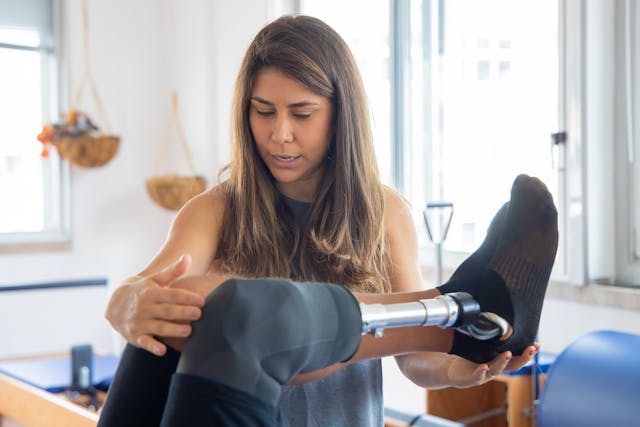
These feet are designed for users who need more from their prosthesis. Whether you walk long distances, move quickly, or want a foot that helps reduce effort, energy-storage feet offer a big leap forward in comfort and performance.
How These Feet Work with Your Movement
Energy-storage feet are made from lightweight, spring-like materials that compress when your heel strikes the ground and release that energy when you push off with your toe. This creates a smooth, bouncing motion that feels more natural and uses less energy.
These feet also offer better shock absorption and a more flexible step pattern. They help reduce fatigue and allow users to walk with better rhythm and speed. Some models are even designed to adjust slightly based on step pressure, making them feel more responsive.
Robobionics has introduced several energy-storage feet into our transtibial and transfemoral prosthetic systems, helping users walk longer with less effort.
Great Choice for Active Transtibial Amputees
If you walk a lot for work, travel, or simply enjoy staying active, an energy-return foot can make a big difference. Transtibial users who have a stable socket and good control benefit from the extra push and flexibility these feet offer.
These feet are also helpful for users who want to walk faster, navigate busy areas, or perform light physical activities. They offer better shock absorption than rigid feet and reduce pressure on the joints and lower back.
We match each user with a foot based on weight, height, and activity level so the energy return feels balanced and not too bouncy or soft.
Supporting High-Mobility Above-Knee Users
For transfemoral users with strong hips and good prosthetic knee control, energy-storage feet can unlock a higher level of mobility. They work best when paired with microprocessor or hydraulic knees that adjust in sync with the foot motion.
This setup allows for smoother transitions between steps, better ground clearance, and improved posture during walking. It also helps reduce the drag or delay that some users feel when stepping forward with a prosthetic knee.
Robobionics provides full system evaluations to make sure foot and knee combinations work in harmony, giving our users more control and better energy savings throughout the day.
Microprocessor and Smart Feet: The Future of Movement
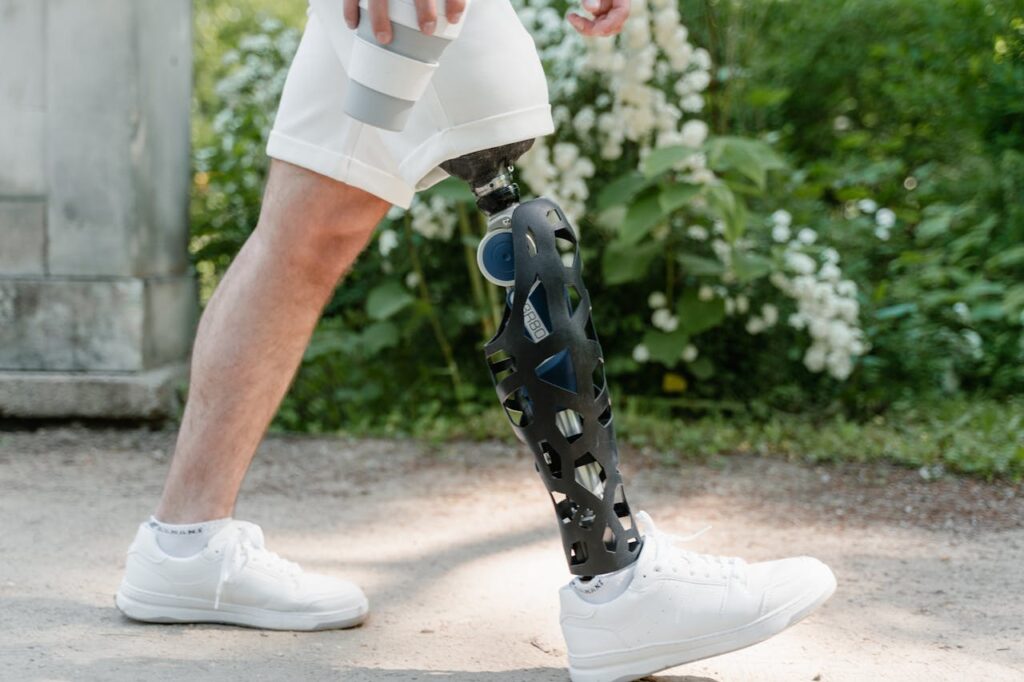
As prosthetic technology continues to advance, the most cutting-edge options now include smart, microprocessor-controlled feet. These feet are designed to actively respond to how you walk, adjusting in real time to give you better balance, smoother motion, and more comfort—especially on changing terrain.
How Smart Feet Adapt to Each Step
Microprocessor feet use sensors to read your movement, speed, and the angle of the ground under you. Based on this information, the foot automatically adjusts its stiffness, ankle angle, and resistance. This means it gives more support when needed and more flexibility when possible, all without you having to think about it.
This intelligent response helps maintain a natural walking rhythm, especially when going up or down slopes or switching from walking to standing. The foot recognizes what you’re doing and adapts instantly. That reduces the mental and physical effort needed to stay balanced.
At Robobionics, we work with smart foot systems that are designed to be both advanced and easy to use. The settings are personalized for each user during the fitting process, so once the foot is set up, it does the work in the background.
Ideal for High-Functioning Transtibial Users
Smart feet offer real benefits for transtibial users who already have strong control and want to walk more efficiently. The foot’s real-time adjustments improve how your step flows, especially during long walks, on uneven surfaces, or when carrying weight.
They are especially useful for users who want more natural motion without relying solely on muscle power. The foot’s response helps reduce pressure on the sound leg and spine, making walking less tiring overall.
These devices do require charging and occasional software updates, but they can significantly improve daily comfort and performance when used correctly.
Perfect Pairing with Microprocessor Knees for Transfemoral Users
For transfemoral users, smart feet are often combined with microprocessor-controlled knees. This combination creates a highly adaptive prosthetic system that works as close to a natural leg as possible. As the knee responds to your motion, the foot adjusts its angle and stiffness to match.
This creates a much smoother, more confident walking experience. It also helps users feel safer when moving in unfamiliar places or navigating stairs and ramps. The foot’s ability to stay stable while the body moves above it can be life-changing for users who’ve struggled with balance or joint pain.
Robobionics helps advanced users choose and test these systems during a demo period to ensure the setup fits their lifestyle. We also offer training to help users get the most out of their smart systems, so they feel in control—not confused—by the technology.
Customizing the Right Prosthetic Foot for You
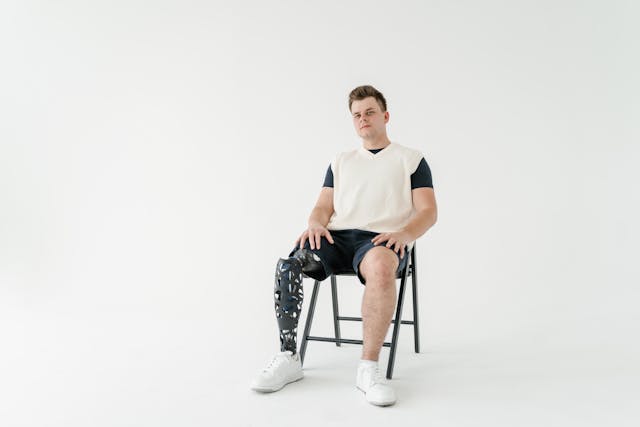
No two people walk the same way, and no single foot works best for everyone. The best prosthetic foot is the one that works in harmony with your body, your goals, and your day-to-day life. That’s why choosing the right foot is more than just picking a model—it’s about personalizing the whole experience.
Matching the Foot to Your Lifestyle
Your daily routine is one of the biggest factors in choosing a prosthetic foot. Do you walk long distances? Stay mostly indoors? Work on uneven ground? Need to stand for long hours? Each of these details matters. A foot that works for a quiet office job might not be right for someone working on a farm or walking through city traffic.
Robobionics begins every fitting with a lifestyle assessment to understand how you move throughout your day. This helps us guide you toward a foot that matches your real-world needs—not just something that looks good on paper.
From basic SACH feet to advanced smart feet, we provide clear, honest advice to help you make a choice that supports your independence and long-term comfort.
Considering Strength, Control, and Rehab Progress
Some feet work best for users with strong muscles and good balance. Others are better for those who are still building strength or recovering from surgery. Your current rehab level and physical condition help determine which foot you’ll feel most stable and confident using.
If you’re still early in your mobility journey, you might start with a stable, supportive foot and upgrade later as your balance and coordination improve. On the other hand, if you’re active and experienced, a dynamic or smart foot might help you reach a new level of movement.
At Robobionics, we support you through every phase—from first steps to future upgrades—ensuring your foot choice grows with you and keeps pace with your life.
Fitting, Testing, and Adjusting for the Perfect Match
Choosing a prosthetic foot is not just a one-time decision. Even the right model needs fine-tuning to feel perfect. That’s why we take time to fit the foot, align it correctly with the rest of your prosthetic, and give you time to test it in real situations.
During the trial period, we check how your body responds to the foot, how your steps look and feel, and whether any adjustments are needed. If something feels off, we make changes until it’s just right.
With our expert fitting team, rehab partners, and follow-up care, Robobionics ensures you don’t just get a prosthetic foot—you get a setup that truly supports your journey toward better movement.
Conclusion
The best prosthetic foot is the one that fits your body, matches your life, and helps you move with confidence. Whether you’re a below-knee or above-knee amputee, the right foot can reduce effort, improve comfort, and give you a smoother, more natural walking experience.
From basic SACH models to energy-storing feet and smart, microprocessor-controlled systems, 2024 offers more choices than ever before. And while the options can feel overwhelming, you don’t have to decide alone. At Robobionics, we guide you through every step—helping you test, train, and adjust until everything feels just right.
Book a free consultation with Robobionics today and discover the prosthetic foot that’s built to move with you, every step of the way.



